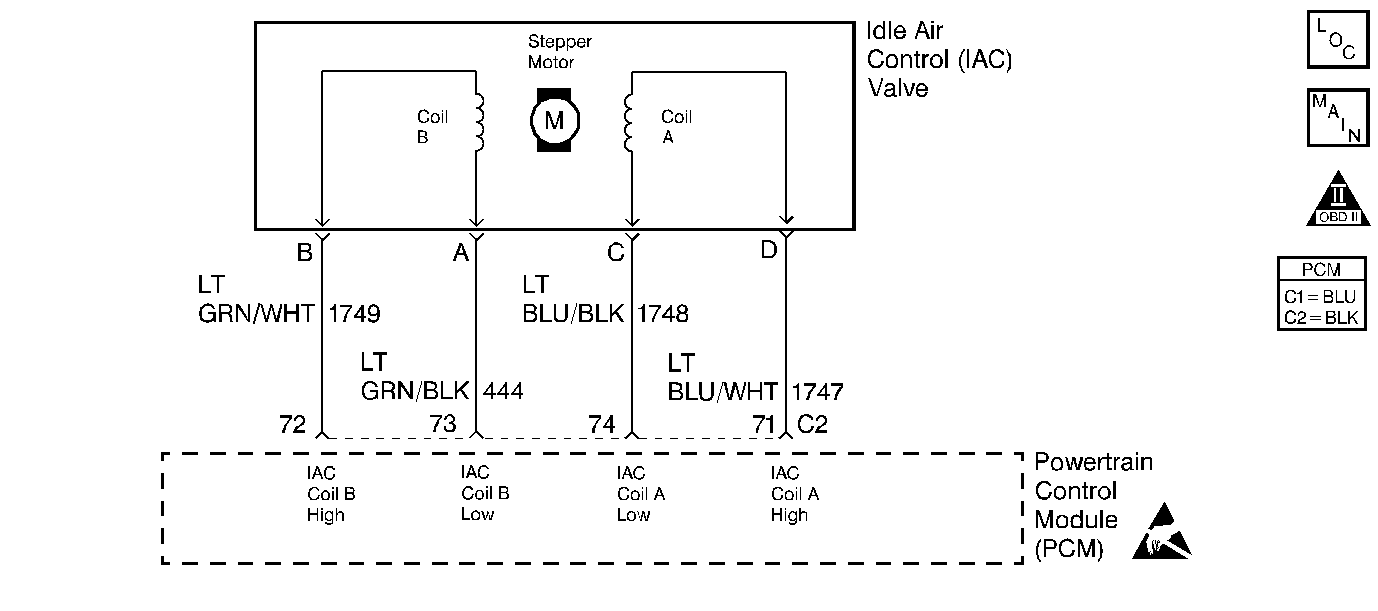
Circuit Description
The powertrain control module (PCM) controls the air entering into the engine with an idle air control (IAC) valve. In order to increase the idle RPM, the PCM commands the pintle inside the IAC valve away from the throttle body seat. This allows more air to bypass through the throttle blade. In order to decrease the RPM, the PCM commands the pintle towards the throttle body seat. This reduces the amount of air bypassing the throttle blade. A scan tool will read the IAC valve pintle position in counts. The higher the counts, the more air that is allowed to bypass the throttle blade.
Conditions for Running the DTC
| • | DTCs P0105, P0107, P0108, P0112, P0113, P0117, P0118, P0122, P0123, P0125, P0128, P0131, P0132, P0133, P0134, P0171, P0172, P0179, P0201 P0202, P0203, P0204, P0300, P0336, P0440, P0442, P0446, P0453, P0502, P1133 and P1441 are not set |
| • | BARO is more than 72 kPa. |
| • | The engine coolant temperature ( ECT) is more than 40°C (104°F). |
| • | Engine has been running more than 20 seconds. |
| • | Battery voltage is between 10.0 volts and 17.1 volts. |
| • | Idle speed is more than 60 RPM above desired. |
Conditions for Setting the DTC
The IAC valve reads less than 2 counts on the scan tool.
Action Taken When the DTC Sets
| • | The malfunction indicator lamp (MIL) will illuminate after 2 consecutive ignition cycles in which the diagnostic runs with the malfunction present. |
| • | The PCM will record the operating conditions at the time that the diagnostic fails. This information will store in the Freeze Frame and Failure Records buffers. |
| • | A history DTC stores. |
Conditions for Clearing the MIL/DTC
| • | The MIL will turn OFF after 3 consecutive ignition cycles in which the diagnostic runs without a fault. |
| • | A history DTC will clear after 40 consecutive warm up cycles without a fault. |
| • | A scan tool can clear the DTCs. |
Diagnostic Aids
| • | Inspect the IAC valve electrical connection for proper mating. |
| • | Inspect the wiring harness for damage. |
| • | Inspect for a disconnected, cracked or cut vacuum hose. |
| • | Inspect for the proper installation of the crankcase ventilation valve. |
| • | Inspect the intake manifold and throttle body for leaks. |
| • | Inspect the intake manifold for cracks. |
| • | Refer to Rough, Unstable, or Incorrect Idle and Stalling . |
Test Description
The numbers below refer to the step numbers on the diagnostic table.
-
The Powertrain OBD System Check prompts you to complete some of the basic checks and to store the Freeze Frame and Failure Records data on the scan tool if applicable. This creates an electronic copy of the data captured when the malfunction occurred. The scan tool stores this data for later reference.
-
A normally operating IAC system will be able to extend and retract by a scan tool and change the engine idle RPM. The valve movement is verified by an engine RPM change.
-
Reprogram the replacement PCM and perform the Crankshaft Position System Variation Learn Procedure. Refer to the latest Techline information for PCM programming.
-
If no malfunctions are present at this point and no additional DTCs were set, refer to Diagnostic Aids for additional checks and information.
Step | Action | Values | Yes | No | ||||
|---|---|---|---|---|---|---|---|---|
Did you perform the Powertrain On-Board Diagnostic (OBD) System Check? | -- | |||||||
Does the engine RPM change smoothly when commanded by the scan tool? | 900-2,000 RPM | Go to Diagnostic Aids | ||||||
3 |
Does the engine RPM change smoothly when commanded by the IAC driver? | - | ||||||
4 |
Was a repair necessary? | -- | ||||||
5 |
Was a condition found? | -- | ||||||
6 |
Was a repair necessary? | -- | ||||||
7 | Replace the IAC valve. Refer to Idle Air Control Valve Replacement . Is the action complete? | -- | - | |||||
|
Important: The replacement PCM must be programmed. Replace the PCM. Refer to Powertrain Control Module Replacement/Programming . Is the action complete? | -- | - | ||||||
9 |
Does the scan tool indicate that this diagnostic has Ran and Passed? | -- | ||||||
Check to see if any additional DTCs are set. Does the scan tool display any DTCs that you have not diagnosed? | -- | Go to applicable DTC table | System OK |
